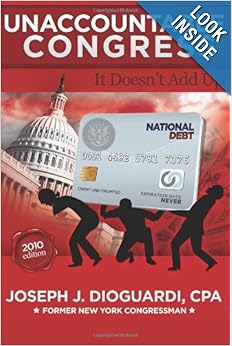The top twelve deficit gimmicks the President & Congress use to defraud the American people
 Joseph J. Dioguardi is a former member of Congress from New York and Certified Public Accountant. Dioguardi in his book “Unaccountable Congress: It Doesn’t Add Up” lists the top twelve gimmicks Congress uses to hide the true costs of government from the people. These gimmicks have been used for decades by both Republican and Democrat administrations, Congresses under both parties and government agencies.
Joseph J. Dioguardi is a former member of Congress from New York and Certified Public Accountant. Dioguardi in his book “Unaccountable Congress: It Doesn’t Add Up” lists the top twelve gimmicks Congress uses to hide the true costs of government from the people. These gimmicks have been used for decades by both Republican and Democrat administrations, Congresses under both parties and government agencies.
The idea behind these gimmicks is to “[K]eep Americans in the dark (or – I should say – in the red!), writes, Dioguardi.
Dioguardi calls this “plastic budgeting”. As David A. Stockman, former Director of the Office of Management and Budget (OMB) under Ronald Reagan, stated, “As the fiscal crisis has worsened and the political conflict intensified we have increasingly resorted to squaring the circle with accounting gimmicks, evasions, half-truths and downright dishonesty in our budget numbers, debate and advocacy. Indeed, if the Securities and Exchange Commission had jurisdiction over the executive and legislative branches, many of us would be in jail.”
Fast forward to the 2013 “fiscal crisis” and “political conflict” in Washington, D.C. since October 1st.
Dioguardi characterizes the government budget as, “[F]ar from rock solid. It is metaphorically, plastic budgeting, approved by people with little plastic cards and elastic standards of fiscal integrity.” He lists the following “dirty dozen” methods of “budget chicanery developed over the years.” The following are taken from Chapter 2 of Dioguardi’s book. Readers can point to current examples of each gimmick being used today by the President and Congress.
GIMMICK 1: FUDGING THE ECONOMIC NUMBERS
When you project a federal budget for a future year, someone has to arrive at a set of crucial economic assumptions…But what are the “best” numbers and assumptions to use? That depends in large part upon for whom one works. The OMB, the Executive Office of the President, tends to generate numbers that will make the president look good – usually low inflation, high real growth, low interest rates, and a shrinking budget deficit. For example, the 1982 budget resolution forecast a $1 billion surplus for fiscal year 1984; in fact, there was a $175 billion deficit.
GIMMICK 2: OFF-BUDGET TREATMENT
If your spending program threatens to increase the budget deficit, there is a very straightforward way of neutralizing it: Put it “off budget.” A recent example of this technique lies in the operation of the Strategic Petroleum Reserve (SPR). It takes tax dollars to fill up the SPR with purchased oil, and that exacerbates the deficit. So in 1989 the Bush Administration simply declared the reserve to be off budget. That reduced the expected deficit by $3.7 billion, but the Treasury had to go out and borrow the money to pay for it.
GIMMICK 3: THE CURRENT SERVICES BUDGET
The 1974 Budget Act requires the president to submit a “current services” budget showing what it would cost to keep government running another year if there were no changes in policy. Congress’ trick is to make a change in policy to restrain spending, then brag about a cut, when in fact the only cut is to the projected level of spending under existing policy.
GIMMICK 4: THE MAGIC ASTERISK
The magic asterisk is probably one of the most notorious budget gimmicks, and also one of the easiest to understand. In his book David Stockman describes its invention in the crucial 1981 budget very candidly. The [Reagan] Administrations “Chapter Two” reductions fell far short of the $130 billion needed to meet the budget target. “Bookkeeping invention this began its wondrous works. We invented the ‘magic asterisk.’ If we couldn’t find saving in time – and we couldn’t – we would issue an IOU. We would call it ‘future savings to be identified.’ It was marvelously creative. A magic asterisk item would cost a negative $30 billion … $40 billion … whatever it took to get a balanced budget in 1984 after we totaled up all the individual budget cuts we’d actually approved.” That year the magic asterisk came out to equal $44 billion.
GIMMICK 5: THE FRAUD, WASTE AND ABUSES EXCUSE
Since there are few if any defenders of fraud, waste and abuse, a member of Congress can denounce such things with impunity, and sound very good to the constituents back home. Actually achieving savings by rooting out these costly activities is a lot more difficult. For instance, in the fiscal 1982 budget, the House Budget Committee simply invented savings of $6 billion the expected benefit from finding and eliminating the terrible threesome.
GIMMICK 6: TRUST FUND DEFICIT MASKING
This is a dandy little scam because it produces big numbers – mainly because the biggest trust fund is Social Security…Now one of the most cherished Social Security fictions is that the trust fund balance is invested to accumulate at interest for 30 or 40 years, until it is needed to pay benefits to future retirees. Of course, nobody had the faintest idea where the fraud, waste and abuse could or would be found. Congress just declared that eliminating it would produce this amount of savings…[T]here is no such trust fund in any meaningful sense: it is just the accounting equivalent of a large cookie jar filled with notes reading “Ma, I’ll pay the missing cookies back later – honest.
GIMMICK 7: THE GIVE-AND-TAKE
The debt limit increase bill of 1972 contained a bold, unequivocal provision, section 201(a), which declared that not a penny more than $250 billion could be spent on federal programs in fiscal year 1973. Immediately below it came section 201(b), which said the ceiling imposed by section 201(a) would become null and void one day after the bill was signed into law, along with any action taken during that one day – presumably by President Nixon.
GIMMICK 8: PHONY LIABILITY VALUATIONS
What if you unwisely lend your shiftless brother-in-law $5,000 to buy a used car, and soon after he skips town for Mexico. You are later asked by your bank for a net-worth statement so you can get a loan for a new home. On your statement, under “Assets,” you put “Promissory note – $5,000″…Unfortunately Uncle Sam makes this kind of bluff all the time. For example, the Federal Deposit Insurance Corporation (FDIC), which insures your bank account to $100,000, collects premiums from banks to build up a reserve…But in the 1980s a massive contraction of agricultural land values and oil prices hit parts of the county… Banks started going under everywhere. The FDIC continued to value the loans of their insured banks at face value, even though the values obviously were plummeting.
GIMMICK 9: FRONT LOADING
A favorite trick of budgeteers is to front-load a new program – collecting taxes to pay for it for a year or so before the benefits begin to be paid out. Thus for a year or two the deficit is reduced by the new revenues. Only in the later years do the program costs overwhelm the revenues and add to the deficit – but, of course, that somebody else’s problem.
GIMMICK 10: RECONCILIATION SAVINGS
Some of the most creative work ever done by Congress comes in the statements by House committees as to how they propose to meet the guidelines of the first budget resolution. That resolution tells each authorizing committee of the House (and Senate) to adjust its program to meet a target number. “Bold face lying” would be too mild a term to describe the responses to this unwelcome instruction.
GIMMICK 11: SHIFTING SPENDING TO ANOTHER YEAR
This gimmick has been around for a long time and is very popular. If requires only changing the date of an expenditure to fall into a different fiscal year, so that the current fiscal year’s deficit objectives are more likely to be met.
GIMMICK 12: THE MONSTER BILL
The bigger and more impenetrable a spending bill is, the more likely it is to conceal lots of budgetary stinkers…The monster bill has another vice. Once passed by Congress, the bill either can be signed or vetoed by the president – there is no middle ground. Thus Congress is fond of throwing in lots of separate provisions that the president ordinarily would veto, but can’t, since he would have to veto the whole bill and shut down the government.
Americans are waking up to these gimmicks and others used to pull the wool over their eyes. Since Dioguardi wrote his book we have seen TARP, QE 1 and QE 2, massive fraud, waste and abuse in multiple government programs and bailouts of banks, investments in pet green projects and the auto industry. All gimmicks that cost taxpayers, not the members of Congress.
RELATED: The Most Expensive Credit Card in the World – A Congressman’s Voting Card



Trackbacks & Pingbacks
[…] The idea behind these gimmicks is to “[K]eep Americans in the dark,” writes Dioguardi. Read more here. […]
[…] http://watchdogwire.com/florida/2013/10/11/the-top-twelve-ways-congress-defrauds-the-american-people… […]
Comments are closed.